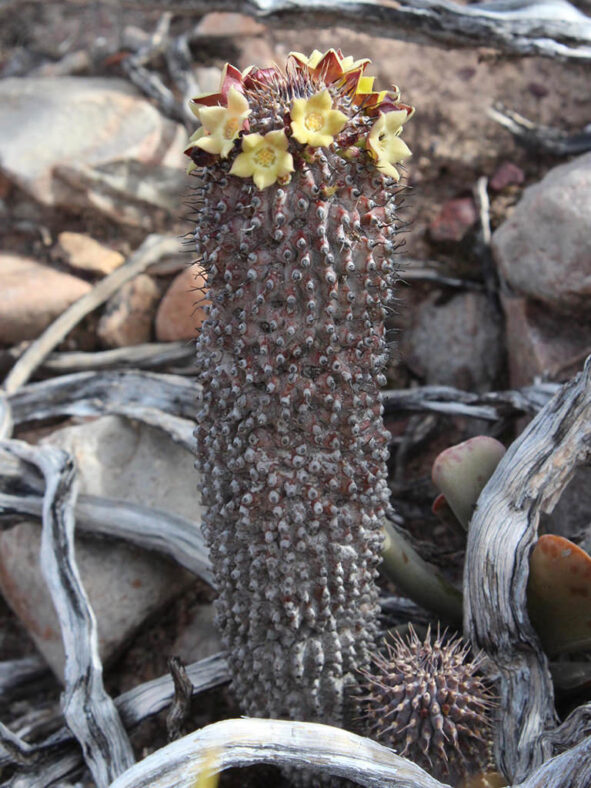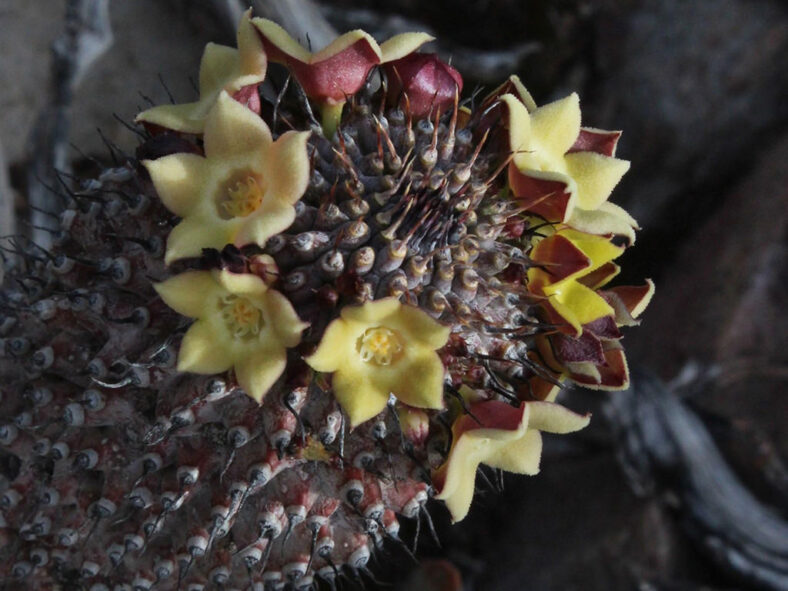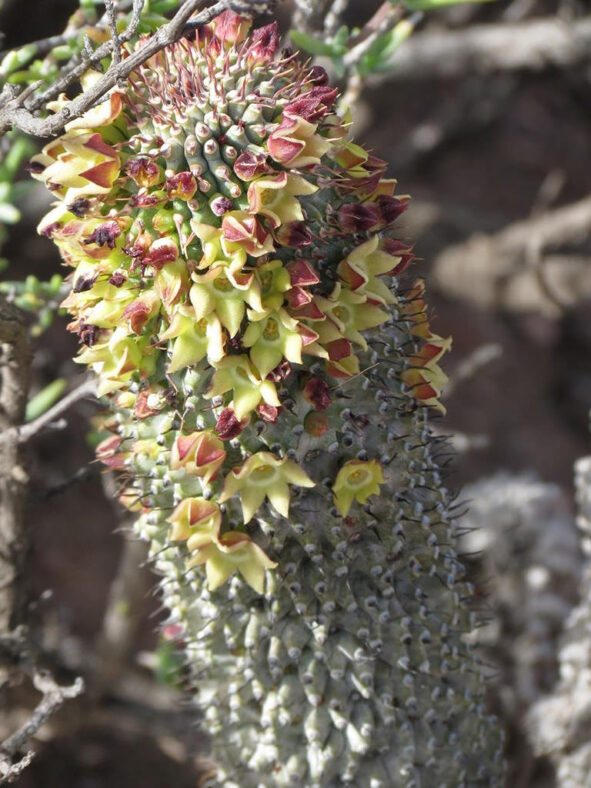Hoodia pilifera subsp. pillansii is a succulent plant that resembles a cactus. Unlike other subspecies, it lacks a raised, thickened annulus in the corolla.
Scientific Name
Hoodia pilifera subsp. pillansii (N.E.Br.) Bruyns
Synonym(s)
Ceropegia coleorum, Hoodia coleorum, Hoodia grandis, Trichocaulon pillansii
Scientific Classification
Family: Apocynaceae
Subfamily: Asclepiadoideae
Tribe: Ceropegieae
Genus: Hoodia
Etymology
The subspecific epithet "pillansii" (pronounced "pil-AN-see-eye") honors Neville Stuart Pillans (1884–1964), a South African botanist.
Origin
Hoodia pilifera subsp. pillansii is native to South Africa. It grows among bushes on stony slopes in the southern Great Karoo and Little Karoo between Matjiesfontein, Merweville, Leeu-Gamka, and Calitzdorp in the Western Cape province.
Description
Hoodia pilifera subsp. pillansii, also known as Hoodia grandis, is a spiny, leafless succulent that forms a dense clump of erect, cylindrical stems. The stems are dark greyish green and have tubercles fused below the middle, forming 20 to 34 ribs along the length of the stem. They can grow up to 32 inches (80 cm) tall and can reach a diameter of 2.4 inches (6 cm). Each tubercle is tipped with a weak spine measuring up to 0.4 inches (1 cm) long. The spines are initially red when young but later dry out to a pale grey.
In the spring, Hoodia pilifera subsp. pillansii produces star-shaped flowers on short stalks. While the flowers can grow up to 8 inches (20 cm) in diameter, they are typically smaller. The flowers are yellow, while the buds are pale maroon. The fruits consist of pairs of erect, horn-like follicles that contain light brown seeds.

How to Grow and Care for Hoodia pilifera subsp. pillansii
Light: Hoodia pilifera subsp. pillansii prefers full sun but will benefit from light shade during the hottest summer days. Indoors, place the plant near the brightest window of your home because it will stretch if it does not receive enough sunlight. Avoid abruptly moving a plant adapted to lower light levels to full sun to prevent sunburn.
Soil: Use commercial potting soil mix for succulents or prepare your own with 50% to 70% mineral grit, such as coarse sand, pumice, or perlite.
Temperature: The plant thrives in warm outdoor environments with low to moderate humidity. It does not like winter cold and should remain fairly dry and warm during its dormancy. Hoodia pilifera subsp. pillansii grows best in USDA Plant Hardiness Zones 10a to 11b, with average minimum winter temperatures ranging from 30°F to 50°F (-1.1°C to 10°C).
Watering: It has typical watering needs for a succulent. From spring to fall, during its growing season, water the plant thoroughly and allow the soil to dry between waterings. When it goes dormant in winter, it needs almost no water, about once a month.
Fertilizing: Fertilizing is a good idea to keep the plant healthy and thriving. Use a water-soluble fertilizer diluted to half the recommended strength, but only during the growing season.
Repotting: Repot Hoodia pilifera subsp. pillansii in spring, just before the growing season. It has shallow roots and does not require too much soil to grow. Always pick a container with drainage holes.
Propagation: The best way to propagate this succulent is by stem cuttings. To ensure good rooting, take cuttings during the growing season. The plant is also easy to start from seeds in spring.
Learn more at How to Grow and Care for Stapeliads.
Toxicity of Hoodia pilifera subsp. pillansii
Hoodia pilifera subsp. pillansii is non-toxic and safe to grow around kids and pets.
Links
- Back to genus Hoodia
- Succupedia: Browse succulents by Scientific Name, Common Name, Genus, Family, USDA Hardiness Zone, Origin, or cacti by Genus
Photo Gallery
Click on a photo to see a larger version.


